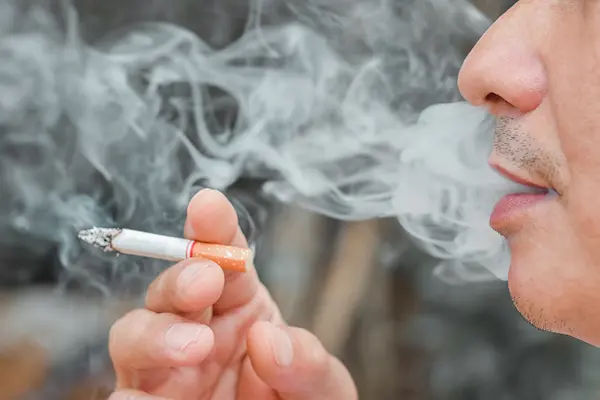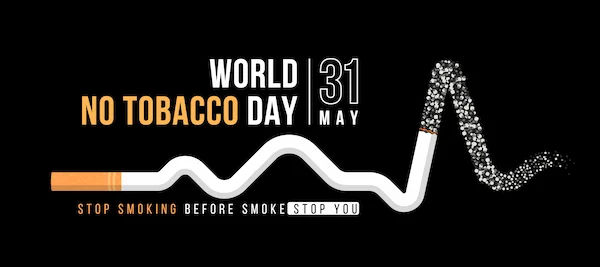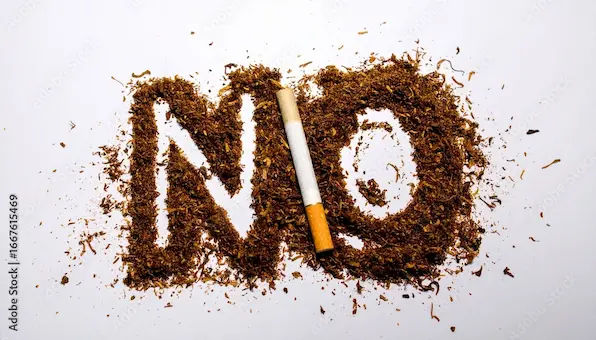The 4000+ Chemicals in Cigarettes: A Shocking Guide to What You're Inhaling
Discover the truth about the 4,000+ chemicals in cigarettes. Learn where they come from, how they damage your body, and why quitting is the only safe choice.

Written by Dr. Dhankecha Mayank Dineshbhai
Reviewed by Dr. Siri Nallapu MBBS
Last updated on 20th Sep, 2025

Introduction
Most people know smoking is bad for you, but few truly grasp the sheer volume and nature of the assault on their bodies. It is not just "tobacco." Every single puff of cigarette smoke is a complex cocktail of over 7,000 chemicals. This includes hundreds that are notoriously harmful, and about 70 that are proven to cause cancer.
This guide will demystify this toxic mixture, moving beyond the number to reveal the specific poisons, carcinogens, and toxic metals you inhale. We will explore where these chemicals come from, what they do inside your body, and why understanding this is the first powerful step toward taking back your health. If you have ever wondered what exactly is in a cigarette, prepare for a revealing journey into the science of smoke.
Beyond Tobacco: The Staggering Number of Chemicals in Cigarette Smoke
The figure "4,000 chemicals" is often cited, but modern research from the FDA and CDC has identified more than 7,000 chemicals in cigarette smoke. This number is so vast it can feel abstract. To put it in perspective, the FDA maintains a list of 93 harmful and potentially harmful constituents (HPHCs) in tobacco products that are prioritised for their significant impact on human health. These are the chemicals that cause cancer, lung disease, heart disease, addiction, and other health problems.
From Plant to Puff: How Do So Many Chemicals Get In There?
You might wonder how a simple tobacco leaf transforms into such a toxic brew. The chemicals come from several sources:
The Tobacco Plant Itself: Nicotine is a natural insecticide produced by the plant. The soil also contributes elements like cadmium and lead, which the plant absorbs.
Additives: Tobacco companies add numerous chemicals to enhance flavour, improve nicotine absorption (such as ammonia compounds), and make the smoke smoother. These additives may seem harmless alone, but when burned, they can create new, dangerous chemical compounds.
Combustion: This is the primary source. The act of burning tobacco at high temperatures (over 900°C in the tip) causes a complex series of chemical reactions, synthesising a multitude of new toxicants from the original components. This is why the smoke is far more dangerous than unburned tobacco.
Consult Top Specialists for Personalised Tips
A Rogue's Gallery: The Most Dangerous Chemicals in Cigarettes
With thousands of chemicals present, it is helpful to focus on some of the most notorious agents of harm. Below are key examples of the most dangerous chemicals found in cigarettes.
Known Human Carcinogens: The Cancer-Causing Agents
These are substances directly linked to causing cancer in humans.
1. Formaldehyde: More Than Just Preservative
Commonly used to preserve dead bodies, formaldehyde in cigarette smoke is a brutal respiratory irritant and a known cause of leukaemia and cancers in nasal and respiratory tissues.
2. Benzene: An Industrial Solvent in Your Lungs
This compound is found in petrol and industrial solvents. Long-term exposure to benzene from smoking is a leading cause of acute myeloid leukaemia (AML).
3. Arsenic: A Classic Poison for Chronic Poisoning
Does cigarette smoke contain arsenic? Yes. Arsenic is used in pesticides and is notoriously poisonous. It accumulates in the body over time, contributing to cancer, heart disease, and impairing the body’s natural repair processes.
Toxic Heavy Metals: Accumulating Poisons
Heavy metals build up in the body over time, causing lasting harm to vital organs.
1. Cadmium: A Carcinogen That Damages Your Kidneys
What is cadmium used for in cigarettes? It is not added; it is absorbed by the tobacco plant from the soil. Cadmium is a known carcinogen that also damages the kidneys and the linings of arteries. It is a key component of battery acid.
2. Lead: Neurotoxin in Every Puff
Lead is a potent neurotoxin that can affect brain development and function. There is no safe level of lead exposure, yet smokers have significantly higher levels in their blood than non-smokers.
Radioactive Particles: An Invisible Danger
One of the most shocking inclusions in cigarette smoke is radioactive material.
Polonium-210: The Hidden Radioactive Element
Tobacco plants absorb radioactive elements like polonium-210 from the soil and phosphate fertilisers. When inhaled, these radioactive particles lodge in the lungs’ tiny airways, continuously emitting radiation and significantly contributing to lung cancer.
The Addictive Engine: Nicotine and Its Role
While not a primary cause of cancer itself, nicotine is the chemical that keeps smokers hooked, ensuring continuous exposure to all the other toxins.
How Nicotine Addiction Works in the Brain
Upon inhalation, nicotine rushes to the brain within seconds, binding to receptors and triggering a flood of dopamine, the "feel-good" neurotransmitter. This creates a powerful reward feedback loop. Your brain quickly adapts, and soon you need nicotine just to feel normal, leading to intense cravings and withdrawal symptoms when you try to quit. This powerful biological mechanism is why quitting is so challenging.
Not Just the Smoker: The Dangers of Secondhand and Thirdhand Smoke
The impact of cigarette smoke extends far beyond the individual smoker.
Secondhand smoke exposes bystanders to the same 7,000+ chemicals, causing numerous health problems in non-smokers, including sudden infant death syndrome (SIDS), respiratory infections, and heart disease.
Thirdhand smoke is the residue that clings to surfaces like clothes, furniture, and walls long after the cigarette is put out. These residual toxic chemicals can be ingested or inhaled, posing a particular risk to infants and children.
Do "Light" or "Natural" Cigarettes Have Fewer Chemicals?
It is a common misconception that "light," "mild," or "natural" cigarettes are safer.
Studies show that smokers of these products often inhale more deeply or smoke more cigarettes to achieve the same nicotine effect, maintaining exposure to similar levels of harmful chemicals. In short, there is no safe cigarette.
The Health Impact: What These Chemicals Do to Your Body
The constant bombardment of these toxins causes systemic harm that affects nearly every organ.
• Cancer: More than 70 carcinogens trigger DNA mutations, leading to cancers of the lungs, mouth, throat, oesophagus, stomach, pancreas, kidneys, bladder, cervix, and blood (leukaemia).
• Cardiovascular Disease: Carbon monoxide reduces oxygen in the blood, while other chemicals damage blood vessels, leading to heart attacks, strokes, and peripheral artery disease.
• Chronic Obstructive Pulmonary Disease (COPD): Toxins like acrolein and cyanide destroy lung tissue and cause chronic bronchitis, making breathing difficult.
• Compromised Immune System: Chemicals suppress immune function, leaving smokers more susceptible to infections.
If you are experiencing a persistent cough, shortness of breath, or other respiratory issues, it is crucial to consult a doctor. You can consult a pulmonologist online with Apollo24|7 for an initial evaluation and advice on the next steps.
Conclusion
Understanding the 4,000+ chemicals in cigarettes, a number that is, in reality, much higher, moves the risk of smoking from an abstract warning to a tangible reality. Each chemical, from the addictive grip of nicotine to the cancer-causing formaldehyde and the radioactive decay of polonium, plays a part in damaging your health.
This knowledge is not meant to instil fear, but to empower. It underscores a simple, undeniable truth: quitting smoking is the single most important action you can take for your health. The human body has a remarkable ability to heal. From the moment you quit, your body begins to repair itself, reducing your risk of disease and adding years to your life.
The journey to quit can be challenging, but you do not have to do it alone. Seek support, use available resources, and take that first step towards a cleaner, healthier life today.
Consult Top Specialists
Consult Top Specialists for Personalised Tips

Dr. Mohamed Azeem
General Physician/ Internal Medicine Specialist
2 Years • MBBS,MD(Internal Medicine) CCEBDM
Karaikudi
Apollo Hospitals Karaikudi, Karaikudi

Dr. Aakash Garg
Gastroenterology/gi Medicine Specialist
12 Years • MBBS, DNB (Medicine), DrNB (Gastroentrology).
Bilaspur
Apollo Hospitals Seepat Road, Bilaspur
(150+ Patients)

Dr. Jyotish R Nair
General Physician/ Internal Medicine Specialist
22 Years • MBBS, MD (General Medicine), PG Diploma(Diabetology)
Angamaly
Apollo Hospitals Karukutty, Angamaly
(150+ Patients)

Dr. R Gopakumar
Internal Medicine/ Covid Consultation Specialist
31 Years • MBBS, MD(general medicine
Angamaly
Apollo Hospitals Karukutty, Angamaly
(25+ Patients)

Dr. Pallavi Patekar
General Physician/ Internal Medicine Specialist
11 Years • MBBS, DNB ( Gnternal Medicine), FCCCM Critical Care
Mumbai
Apollo Hospitals CBD Belapur, Mumbai
Consult Top Specialists

Dr. Mohamed Azeem
General Physician/ Internal Medicine Specialist
2 Years • MBBS,MD(Internal Medicine) CCEBDM
Karaikudi
Apollo Hospitals Karaikudi, Karaikudi

Dr. Aakash Garg
Gastroenterology/gi Medicine Specialist
12 Years • MBBS, DNB (Medicine), DrNB (Gastroentrology).
Bilaspur
Apollo Hospitals Seepat Road, Bilaspur
(150+ Patients)

Dr. Jyotish R Nair
General Physician/ Internal Medicine Specialist
22 Years • MBBS, MD (General Medicine), PG Diploma(Diabetology)
Angamaly
Apollo Hospitals Karukutty, Angamaly
(150+ Patients)

Dr. R Gopakumar
Internal Medicine/ Covid Consultation Specialist
31 Years • MBBS, MD(general medicine
Angamaly
Apollo Hospitals Karukutty, Angamaly
(25+ Patients)

Dr. Pallavi Patekar
General Physician/ Internal Medicine Specialist
11 Years • MBBS, DNB ( Gnternal Medicine), FCCCM Critical Care
Mumbai
Apollo Hospitals CBD Belapur, Mumbai
More articles from Smoking Cessation
Frequently Asked Questions
What is the deadliest chemical in a cigarette?
It is difficult to single out one, as the combined effect is what makes smoke so lethal. However, carcinogens like formaldehyde, benzene, and polonium-210 are among the most potent for causing cancer, while hydrogen cyanide and carbon monoxide contribute significantly to heart and lung disease.
Are the chemicals added or do they occur naturally?
Both. Some, like nicotine, occur naturally in tobacco. Others are added during manufacturing for flavour and to enhance nicotine delivery. However, the vast majority of toxicants are created when the cigarette is burned and the components undergo combustion.
Do e-cigarettes or vapes contain the same chemicals?
E-cigarette aerosol is chemically different from tobacco smoke and generally contains fewer toxic chemicals. However, it is not harmless. It can contain nicotine, ultrafine particles, flavourings linked to lung disease (such as diacetyl), and volatile organic compounds (VOCs). The long-term health effects are still being studied.
How long do these chemicals stay in your body after you quit?
It varies. Nicotine leaves your bloodstream within 1–3 days. However, toxins like cadmium can persist in the kidneys for decades. The good news is that your body begins healing within 20 minutes of your last cigarette, and significant health benefits accumulate over time.
Can your lungs fully recover from years of smoking?
While your lungs can significantly heal and your risk of disease drops dramatically, they may not return to the exact state of a never-smoker’s lungs, especially if emphysema has destroyed lung tissue. However, quitting at any age stops further damage and leads to immense improvements in breathing and quality of life.




